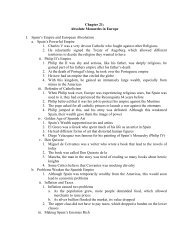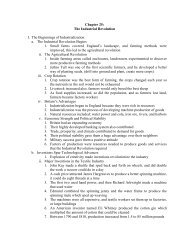1/15 © Copyrighted Material Spanish Final Study Sheet Ser vs. Estar ...
1/15 © Copyrighted Material Spanish Final Study Sheet Ser vs. Estar ...
1/15 © Copyrighted Material Spanish Final Study Sheet Ser vs. Estar ...
Create successful ePaper yourself
Turn your PDF publications into a flip-book with our unique Google optimized e-Paper software.
12/<strong>15</strong><br />
c. Irregular Past Participles Ending in –to<br />
The following verbs have irregular past participles ending in –to.<br />
Infinitive Past Participle Meaning<br />
abrir abierto opened<br />
cubrir cubierto covered<br />
descubrir descubierto discovered<br />
escribir escrito written<br />
morir muerto died<br />
poner puesto put<br />
romper roto broken<br />
ver visto seen<br />
volver vuelto returned<br />
The following verbs have irregular past participles ending in –cho.<br />
Infinitive Past Participle Meaning<br />
decir dicho said<br />
hacer hecho done, made<br />
[2] The Present Perfect Tense<br />
a. The present perfect tense is formed by the present tense of the verb haber (to<br />
have) and a past participle<br />
yo<br />
he<br />
tù<br />
has<br />
ud., el, ella ha<br />
visitado/ aprendido/ vivido<br />
nosotros, -as hemos<br />
uds., ellos, ellas han<br />
b. To make a verb in the perfect tenses negative, place no before the verb haber.<br />
To make a verb interrogative, place the subject after the past participle.<br />
No han vivido allí.<br />
They haven’t lived there.<br />
¿Ha visto Ud. la película Have you seen the film<br />
Yo no me he bañado todavía. I haven’t bathed myself yet.<br />
Note: Nothing comes between the verb haber and the past participle.<br />
Pronouns (reflexive and object) come before the verb haber.<br />
c. The present perfect tense is used to describe an action that began in the past and<br />
continues up to the present or an action that took place in the past but is connected<br />
with the present.<br />
[3] The Pluperfect Tense<br />
a. The pluperfect tense is formed by the imperfect tense of the verb haber (to<br />
have) and a past participle.<br />
yo<br />
había<br />
tù<br />
habías<br />
ud., el, ella había<br />
visitado/ aprendido/ vivido<br />
nosotros, -as habíamos<br />
uds., ellos, ellas habían<br />
b. The pluperfect tnese is used to describe an action that was completed in the past<br />
before another action took place<br />
Yo los había visitado antes.<br />
I had visited them before.<br />
© <strong>Copyrighted</strong> <strong>Material</strong>







